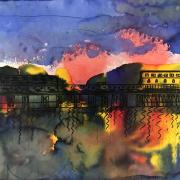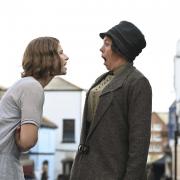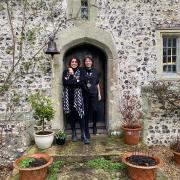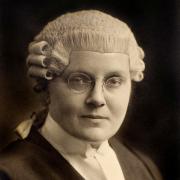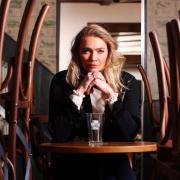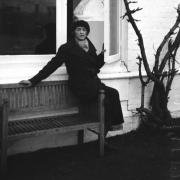Clive Agran take his life in his hands and glides masterfully onto the ice
Some things are baffling. Take electricity, for example. Although I passed ‘O’ level physics (just), I’ve never really understood how it works. For instance, we’re told all electricity has to be earthed, but what about aeroplanes? Do they make some other arrangement? And then there’s Sir Bruce Forsyth. How is it some people find him entertaining?
Sport, too, is full of inexplicable phenomena. First and foremost among these is the Fosbury Flop. A keen exponent of the Western Roll myself, I simply don’t understand how it is that high-jumpers are able to launch themselves backwards and clear the incredible heights they do. When you’re walking towards a door, do you ever think to yourself I could comfortably clear that if, on take-off, I suddenly moved from an inward lean to outwards, thereby producing a rotation of my body along the axis of the top of the door that, combined with the rotation around my vertical axis produced by the drive leg, will result in a body position that will be laid out supine at ninety degrees with the head and shoulders clearing the top before the trunk and legs? Yeah, that should work!
Only a couple of inches behind the Fosbury Flop in terms of total bewilderment is that manoeuvre in ice skating where the skater spins, in itself quite difficult to comprehend, and then spins progressively faster as he or she pulls in her arms and legs. Leaving to one side the business of how anyone could then skate on without promptly collapsing on the ice overwhelmed by dizziness, how do they do it? In case you’re interested, Natalia Kanounnikova’s 308 revolutions per minute is the current world record for the fastest spinning on ice skates. Not so much to have a crack at the record as to see if I could stand up completely unaided for a minute, I’ve come along to the Royal Pavilion in Brighton for my world ice skating debut.
On checking in, rather disconcertingly, I’m given a wrist band. Although I may be wrong, my suspicion is that, in the event of appalling carnage on the ice, it will make it easier for them to identify my body. Notifying my next of kin shouldn’t pose a problem as my daughter Charlotte is standing right next to me. She’s here to take photos and asks whether the ‘sports’ setting on her camera, presumably with a fast shutter speed to capture the high-speed action, will be appropriate. I’m more concerned about whether a recent shower will have made the ice slippy. “We’re in trouble if it’s not,” is Charlotte’s smart-arse reply.
The quarter-past four session we’ve booked into is sold out (as are all but the very late sessions) but my concern that it will be very crowded and the queues tedious prove to be unfounded as the slick organisation at this temporary facility is impressive. I don’t have to wait to swap my shoes for skates, there are sufficient benches to enable everyone to sit down to strap on their skates and there’s no scrum as we unsteadily clump outside. The previous session finished at four and a machine is now gently gliding to and fro, presumably to smooth the ice and mop up the blood stains. Mini penguins are herded towards us but these useful aids to stability, it is stressed, are strictly for those under the age of eight, which is a shame.
An ‘Ice Marshal’ in fluorescent yellow jacket instructs us to go anti-clockwise, which interests me. Is it something to do with the earth’s magnetism and the way bathwater disappears down the plughole? Do they skate the other way round in the southern hemisphere or, as with driving, is it yet another example of eccentric and perfidious Albion? (By the way, that has nothing to do with Gus Poyet’s brave boys in the blue and white stripes.)
At 4.15 precisely, a gate is opened and we’re allowed onto the ice. “One small step for man…”. My instinct for self preservation prompts me to grab hold of the rail that runs right around the rink and I would remain here for the full hour were there not 249 people behind wanting to come onto the ice. I am obliged to shuffle inelegantly forward. Charlotte, a veteran of three previous skating expeditions, takes hold of my hand and together we slide hesitantly along. I’m genuinely touched by her gesture until she turns to me and says, “If you feel yourself falling, make sure to let go of my hand.”
I feel it prudent to introduce myself to, and make friends with, the on-duty paramedic Mike Crockford. Worryingly, business is fairly brisk, he informs me. “It’s mostly lacerations, abrasions, sprains… that sort of thing.” I edge even closer to the rail around the side. The crude rule of bruised thumb is that the better the skater, the nearer the centre of the rink they are. As you progress out from the middle, so the general standard of skating deteriorates. I have therefore naturally gravitated to be amongst my own kind, absolute beginners.
There is a genuine feeling of camaraderie amongst us as we wobble round. However, there is, literally, a downside to sticking together. Prone as we are to tumble without warning, a prostrate novice can suddenly present an insurmountable obstacle that can bring others down. Like the character Yossarian in Catch 22 who avoids flying his bomber in formation lest one of the other planes is hit and the resultant debris damages his aircraft, I try to keep a healthy distance from the others as not falling has become something of an obsession.
After about a quarter of an hour, a historic landmark is achieved as I complete a full circuit without touching the sides. Who says you can’t teach an old dog new tricks? Emboldened by this achievement, I edge further from the side and am now mixing it with tolerably decent skaters. Almost inevitably, just as I’m contemplating an ambitious triple salchow followed by a double lutz, I find myself flat on my back staring up at the beautifully illuminated, onion-domed Royal Pavilion. Before I can say, “My goodness this ice is very firm,” an ice marshal is extending a hand and helping me back onto my feet. “Try bending the knees more,” are his helpful parting words.
Charlotte, who claims never to have fallen on the ice, suggests I lean forward. The problem with leaning forward, as I see it, is that falling forward is even less appealing than falling backward. In other words, a broken nose is worse than a sore backside. But I shouldn’t dwell on the negatives as the whole experience is great fun. Jolly Christmas carols are playing, the Royal Pavilion looks absolutely splendid and the atmosphere is joyous. Even another fall, this time when a young girl cuts me up on her way to hugging her spectating mother, doesn’t shatter my enjoyment.
“Five minutes left,” announces the public address system. Instead of a desperate last-ditch attempt at Natalia Kanounnikova’s world spinning record, I opt for a couple more gentle circuits. Time’s up. My goodness, how quickly the hour has… er, slipped by.
The rink closed on January 22 but will return in November and then open every day except Christmas Day until the end of January 2013.









